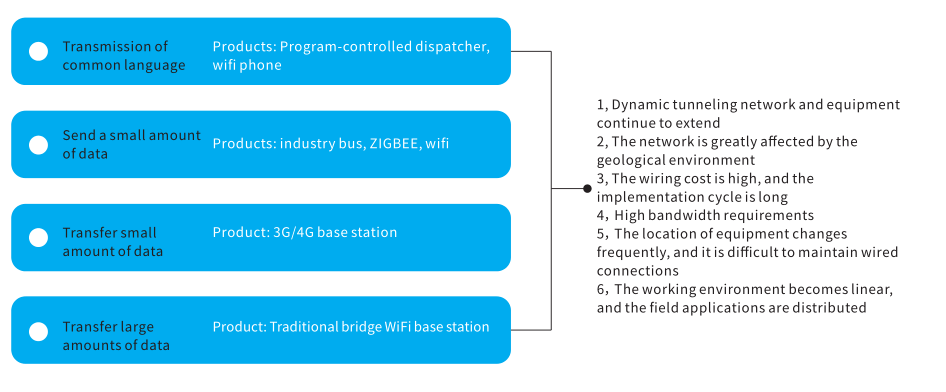Coal Mine Monitoring Data Transmission
Building communication base stations and connecting them has always been a problem that plagued the construction of smart mines.
The current state of communication technology used in mine production:

Aiming at the pain points of the coal mine communication industry, our company listed the industry's first three-band FM self-organizing network base station: wiring-free, self-organizing network, low latency, high broadband, which perfectly solves the communication problems encountered by the mine.

- Qualcomm WiFi industrial grade IPQ4029 chip, support 5G1/5G2/2.4G.
- The wireless combination speed reaches 2200Mbps, reimagining the Wi-Fi experience.
- First choice for wiring-free and self-management projects.
- Transmission distance can reach 1~5 kilometers.
System Features
1. Intelligent networking, automatically avoid channel interference
Wireless communication base stations intelligently identify nearby base stations and automatically form a wireless link bridging network without human intervention; intelligent frequency point scanning and multi-frequency point planning capabilities can avoid interference problems in wireless smart networks. Cooperate with sector and directional antennas to reduce the chance of external interference in networking and coverage.
2. Automatic repair, automatic performance adjustment
Using Layer 2 technology networking, distributed intelligence quickly establishes a topology and convergence network. Each base station establishes the connection direction according to the weighted average of various parameters such as signal strength, link quality, hop count, performance, and delay. Reachability and link indicators perform self-healing and automatic link performance adjustments.
3. Long-distance cableless communication
There is no need for an optical cable connection between wireless communication base stations, and the nearby power supply can complete the WIFI signal coverage.
5.8GWIF1 performs wireless bridging (the bridging distance is controllable, meeting 300-600 meters) to complete the communication data link.
4. Hybrid access network
The wireless communication base station supports 2.4G wireless WIFI signal access, gigabit multi-electric port wired signal access. 5.8G wireless WIFI signal access (optional).
5. Multi-level lossless continuous jump
The wireless base stations support 6-10 grade 5.8G Gigabit WIFI continuous jump connection, after each level jump, the bandwidth loss is within 3%, the overall network delay is within 15ms, and the transmission bandwidth is not less than 300Mbps.
6. Disaster tolerance and fault tolerance link
Base stations support wired connection networking, wireless bridging networking, and wired and wireless hybrid networking. After the wired networking is disconnected, the wireless bridging networking is automatically enabled to maintain the continuity of the communication backbone link.
7. Seamless roaming
The WIFI signals of each base station are all the same, forming the same network, which is implemented by uniform rules, and the base station and the base station perform non-inductive signal switching.
8. Multi-network integrated communication
The WIFI network can be connected to 4G network and administrative telephone and can be interconnected with the original program-controlled dispatching system. In the WIFI environment, no server is required, and the intercom and call can be taken off.
9. Standard open network
Using standard 802.11X protocol, with standard WIFI device access capability, any IP-type device, or device through an IP-based interface, can be directly connected to the system, without the need to compile any drivers and applications to realize the device Wireless and interconnected.
